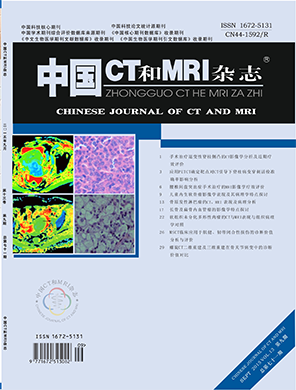论著-头颈部
CTA、MRA在老年后循环缺血病因诊断中的对比分析
作者:严 震1 仇俊华2
所属单位:1.青海省中医院放射科 (青海 西宁 810000) 2.湖北医药学院附属太和医院医学 影像中心 (湖北 十堰 442000)
PDF摘要
目的以DSA为诊断金标准, 探讨CTA、MRA在老年人后循环缺血 (posterior circulation ischemia,PCI) 病因中的诊断价值及优缺点。方法 回顾 性分析经DSA确诊为后循环缺血的35例患 者的脑MRA及CTA图像,并计算两种血管 成像方法对病因诊断准确性。结果 35例 患者共113支血管病变,病变分别位于椎 动脉(49.6% 56/113)、基底动脉(23.0% 26/113)、大脑后动脉(27.4% 31/113)。 MRA、CTA对病变血管的诊断准确率分别 为77.0%、86.7%,与DSA对比,MRA对老 年后循环缺血病因的Kappa值为0.70; CTA对老年后循环缺血病因的Kappa值为 0.82。结论 与MRA相比,CTA在诊断后循 环血管狭窄和闭塞具有更高的准确性, 可作为诊断PCI病因的可靠手段。
Objective To study the value of CT angiography(CTA) and magnetic resonance angiography(MRA) in the diagnosis of the etiology of the elderly posterior circulation ischemia, compared with digital subtraction angiography(DSA). Methods A retro spective analysis of 35 patients diagnosed posterior circulation ischemic were checked by MRA and CTA.The locations of the lesions shown by various imaging techniques were analyzed and the diagnostic accuracy was calculated. Results A total of 113 diseased vessel segments were identified by DSA. After consensus interpretation, the lesions were located in the vertebral artery(49.6% 56/113), basilar artery(23.0% 26/113), posterior cerebral artery (27.4% 31/113).The diagnostic accuracy of MRA, CTA was 77.0%, 86.7% respectively. Compared with DSA, the Kappa value was 0.70, 0.82 for the diagnosis of the etiology of the elderly posterior circulation ischemia. Conclusions CTA has a higher accuracy than MRA and is recommended over TOF MRA for detection of posterior circulation ischemia.CTA results had a significant effect on patient clinical management.
【关键词】后循环缺血;CT血管造影术;磁共振血管造影术
【中图分类号】R743;R445.2;R445.3
【文献标识码】A
【DOI】10.3969/j.issn.1672-5131.2015.09.016
前言
后循环缺血(posterior circulation ischemia,PCI)是指供应脑 部的椎基底动脉系统缺血引起的一过性或持续性的症状,约占全部卒 中及短暂缺血发作的1/5。引起后循环缺血最常见的原因是心源性脑 栓塞,大动脉粥样硬化,小动脉疾病[1]。磁共振血管造影(magnetic resonance angiography,MRA)和CT血管造影(CT angiography,CTA) 都可以用于临床诊断椎-基底动脉病变[2]。本研究通过回顾性分析 45例PCI老年患者的CTA、MRA,并与数字减影心血管造影(digital subtraction angiography,DSA)检查结果相对照,评价其在PCI病因诊 断中的应用价值。
中国CT和MRI杂志
第13卷, 第 9 期
2015年09月

相关文章